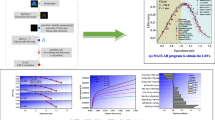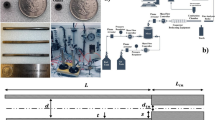Abstract
This paper reports the effects of variations in the fuel composition of H2/CO/CH4 syngas on the characteristics of NO x and CO emissions in a partially-premixed gas turbine combustor. Combustion tests were conducted on a full range of fuel compositions by varying each component gas from 0% to 100% at heat inputs of 40 and 50 kWth. Flame temperature, combustor liner temperature, ignition delay time, and flame structure were investigated computationally and experimentally to judge whether they are significant indicators of NO x and CO formation. The characteristics of and reasons for NO x and CO emissions were investigated by analyzing the emission mechanisms and relationships among fuel property, equivalence ratio, flame temperature, liner temperature, flame shape. The flame structures were investigated using the following flame visualization methods: (1) time-averaged OH* chemiluminescence and its Abel-deconvolution; (2) direct photography; and (3) instantaneous OH-PLIF. The flame structures were greatly changed by the fuel composition and heat input, and they were subjected to key affecting parameters of the temperatures of the flames and the liners. NO x and CO emissions also largely varied according to fuel composition and heat input, showing neither linearly nor exponentially clear proportional trends toward the syngas compositions because of the singular conditions. For example, only the 100% CO flame at low load emitted lots of CO, whereas complete combustion was observed in other cases. However, the qualitative observations showed that the root causes of NO x emission behaviors were flame temperature and flame structure, which were directly related to the residence time in the flame. Various sets of practical test results were obtained, and these results could contribute to the optimal selection of the fuel-feeding condition when fuel is changed from natural gas to syngas in order to minimize NO x and CO emissions with stable combustion.
Similar content being viewed by others
References
Tian X J, Xing S X, Cui Y F, et al. CIVB flashback analysis of hydrogen flame based on azimuthal vorticity at mixing zone exit. Sci China Tech Sci, 2014, 57: 2466–2474
Warnatz J, Maas U, Dibble R W. Combustion, Second ed. Germany: Springer, 1999. 219–231
Walton S M, He X, Zigler B T, et al. An experimental investigation of the ignition properties of hydrogen and carbon monoxide mixtures for syngas turbine applications. Proc Combust Inst, 2007, 31: 3147–3154
Natarajan J, Lieuwen T, Seitzman J. Laminar flame speeds of H2/CO mixtures: Effect of CO2 dilution, preheat temperature, and pressure. Comb and flame, 2007, 151: 104–119
Lieuwen T, McDonell V, Petersen E, et al. Fuel flexibility influences on premixed combustor blowout, flashback, autoignition, and stability. J Eng Gas Turbine Power, 2008, 130: 011506
Dodo S, Asai T, Koizumi H, et al. Performance of a multiple-injection dry low NOx combustor with hydrogen-rich syngas fuels. J Eng Gas Turbine Power, 2013, 135: 011501
Littlejohn D, Cheng R K, Noble D R, et al. Laboratory investigations of low-swirl injectors operating with syngases. J Eng Gas Turbine Power, 2010, 132: 011502
Hasegawa T, Tamaru T. Gas turbine combustion technology reducing both fuel-NOx and thermal NOx emissions for oxygen-blown IGCC with hot/dry synthetic gas cleanup. J Eng Gas Turbine Power, 2007, 129: 358–369
Huang M, Shao W, Xiong Y, et al. Effect of fuel injection velocity on MILD combustion of syngas in axially-staged combustor. Appl Ther Eng, 2014, 66: 485–492
Huang M, Zhang Z, Shao W, et al. Coal-derived syngas MILD combustion in parallel jet forward flow combustor. Appl Ther Eng, 2014, 71: 161–168
Li P, Mi J, Dally B B, et al. Progress and recent trend in MILD combustion. Sci China Tech Sci, 2011, 54: 255–269
Lee M C, Seo S B, Yoon J, et al. Experimental study on the effect of N2, CO2, and steam dilution on the combustion performance of H2 and CO synthetic gas in an industrial gas turbine. Fuel, 2012, 102: 431–438
Davis D W, Therkelsen P L, Littlejohn D, et al. Effects of hydrogen on the thermo-acoustics coupling mechanisms of low-swirl injector flames in a model gas turbine combustor. Proc Combust Inst, 2013, 34: 3135–3143
Allison P M, Driscoll J F, Ihme M. Acoustic characterization of a partially-premixed gas turbine model combustor: Syngas and hydrocarbon fuel comparisons. Proc Combust Inst, 2013, 34: 3145–3153
Joo S, Yoon J, Kim J, et al. NOx emissions characteristics of the partially premixed combustion of H2/CO/CH4 syngas using artificial neural networks. Appl Ther Eng, 2015, 80: 436–444
Williams T C, Shaddix C R. Contamination of carbon monoxide with metal carbonyls: Implications for combustion research. Combust Sci Tech, 2007, 179: 1225–1230
Lee M C, Yoon J, Joo S, et al. Investigation into the cause of high multi-mode combustion instability of H2/CO/CH4 syngas in a partially premixed gas turbine model combustor. Proc Comb Inst, 2015, 35: 3263–3271
Park J, Lee M C. Combustion instability characteristics of H2/CO/ CH4 syngases and synthetic natural gases in a partially-premixed gas turbine combustor: Part II–Time lag analysis. Int J of Hydrogen Energy, 2016,41: 1304–1312
Turns S R. An Introduction to Combustion. Singapore: McGraw-Hill, 1999. 527–560
Petersen E L, Hall J M, Smith S D, et al. Ignition of lean methane- based fuel blends at gas turbine pressures. J Eng Gas Turbines Power, 2007, 129: 937–944
Vries J, Petersen E L. Autoignition of methane-based fuel blends under gas turbine conditions. Proc Combust Inst, 2007, 31: 3163–3171
La Violette M, Perez R. On the prediction of pollutant emission indices from gas turbine combustion chambers. In: Proceedings of American Society of Mechanical Engineers Turbo Expo. Copenhagen: American Society of Mechanical Engineers, 2012
La Violette M, Strawson M. On the prediction of nitrogen oxides from gas turbine combustion chambers using neural networks. In: Proceedings of A American Society of Mechanical Engineers Turbo Expo, Berlin: American Society of Mechanical Engineers, 2008
Author information
Authors and Affiliations
Corresponding author
Rights and permissions
About this article
Cite this article
Lee, M.C. Effects of H2/CO/CH4 syngas composition variation on the NO x and CO emission characteristics in a partially-premixed gas turbine combustor. Sci. China Technol. Sci. 59, 1804–1813 (2016). https://doi.org/10.1007/s11431-016-0099-x
Received:
Accepted:
Published:
Issue Date:
DOI: https://doi.org/10.1007/s11431-016-0099-x




